- 15
May

Department Overview
Head of Department: Prof. Beer Pal Singh (15.01.2020-14.01.2023)
The Physics Department of the Chaudhary Charan Singh University Meerut was established in 1969. The department has the distinction of starting M.Phil degree programme in semester system in the country and subsequently started to offer 4-semester (2-years) M.Sc (Physics) degree with specialization in electronics and Ph.D programme. Currently, the department takes 20-students in M.Sc degree programme and 10-students in M.Phil. The department has the largest faculty amongst the teaching departments of the university. The department of physics has 8-sanctioned faculty positions, which include 2-Professors, 3-Associate Professors and 3-Assistant Professors.
The department today is an active beehive of research being carried out in a wide variety of frontier areas as well as high quality post-graduate and doctoral programs. The research programs of the Department cover a number of areas like Materials Science, Nanotechnology, Renewable Energy, Thin Films, Condensed Matter Physics, MEMS, Nanoparticles, Photonics and Superconductors etc.
The growing international reputation of the Department has enabled it to join several international collaborations such as Marco Polo Cooperation Program on Scientific and Technological Cooperation between the Università degli Studi di Catanzaro "Magna Græcia" (UMG), Italy, and University of Tokyo, Japan. Faculty members are also collaborating with the scientists at University of Puerto Rico, Mayahuez, USA, IUAC, New Delhi, IIT-R etc. The department has undertaken a large number of R&D projects from various sponsoring agencies and is involved in international collaborations and industrial consultancy projects.
The Department's illustrious legacy and its continuous stride in academic excellence over many decades have been duly acknowledged by the Department of Science & Technology, New Delhi, resulting in the endowment of financial assistances through schemes FIST and University Grants Commission, New Delhi. These grants have helped in strengthening the post graduate laboratories and basic infrastructure and the procurement of state of art instruments for research.
Programme/ Courses
The department is currently offering the follwing programmes of study :
Faculty
Head

Professor



Assistant Professor


Syllabus
| Course Name | Download Syllabus |
|---|---|
| M.Sc. (CBCS) with Specialization in Electronics |
Facilities
Library and High Speed Internet (LAN & WLAN) Facilities
Department has visualized the need of departmental library to provide more accessible and more personalized service to students and faculty members and to establish departmental collection in subject of physics. Library has excellent collection of printed books, encyclopedias and journals, e-book and e-journals and scopus and websicence facilities.
Departmental library is well equipped with high speed LAN and WLAN internet facility, to access e-journals open access journals online.
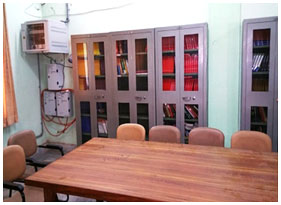
Departmental Library & LAN & WLAN High Speed Internet Facility
LabVIEW-based Interactive Virtual Laboratory
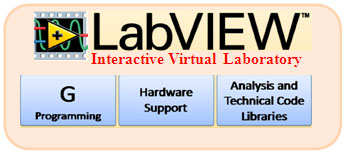
LabVIEW based Interactive Virtual Laboratory
The computer technology and the Internet have the potential to provide a highly interactive and powerful learning environment for physics disciplines. Department has several Dual Core, i3 and i7 based desktop computers for students. LabVIEW™ software and ELVIS based dedicated interactive Virtual Laboratory (VLE) for teaching of electronics has been established.
It consists of two sections: virtual simulation and real-time measurement. The system imparts practical training toward architecture, hardware configuration and system implementation.
This LabVIEW™ facility for teaching circuits and electronics will give students the ability to move seamlessly from theory and experimentation by combining hardware that is based on industry-standard technology with Multisim circuit simulation software. With Multisim, and interactive components, 3D bread boarding, and hardware integration will give students the ability to apply theory to real-world scenarios
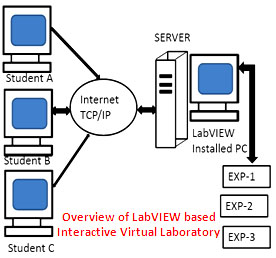
Scanning Tunnelling Microscope
High resolution Scanning Tunneling Microscope (STM) probe has been commissioned at department for advanced material characterization at atomic level. This nanoRev 6 Scanning Tunneling Microscope is made by Quazar Technologies. The nanoREV 6.0 model is an ambient air Table-top STM and is capable to scan ultra-small area of 2mmx2mm with atomic resolution (Min resolution: 3pm). The nanoREV6 is capable to perform I-V and I-Z Spectroscopy, Topography and Local Density of State (LDOS) and Local Barrier Height (LBH) imaging can be done.
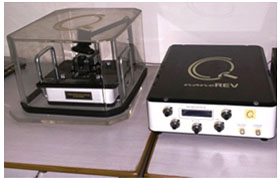
nanoRev 6 ambient Air Table-top
Scanning Probe Microscopy Laboratories for Advanced Material Characterization
Scanning Probe Microscopy facility for material characterization at ultra-small level has been created. The facility has states of art advanced scanning tunneling microscope and versatile scanning probe microscopes.
This facility consist of a versatile and state of art, Scanning Probe Microscope model-F80 from A.P.E Research Italy has been installed which is capable of Contact AFM/ Lateral Force Microscopy, Resonant Mode (semi-contact + noncontact AFM)/ Phase Imaging, Magnetic Force Microscopy, Electrostatic Force Microscopy, Kelvin Probe Microscopy, Adhesion Force Imaging, Spreading Resistance Imaging (SRI), Scanning Capacitance microscopy. STM Scanning Tunneling Microscopy/STM Scanning Tunneling Spectroscopy, a number of other modes.
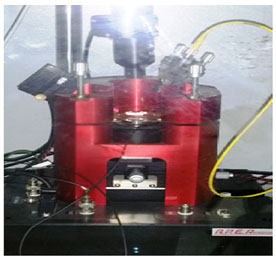
Atomic Force Microscope Model-F80
Micro and Class-1000 Clean Room Facility for Micro and Nanofabrication
Cleanroom environment is used in manufacturing functional electronics device. A Cleanroom is a controlled level of contaminant environment i.e.; a low level of pollutants such as dust, airborne microbes, aerosol particles, and chemical vapors per cubic meter at a specified particle size. An ISO 7 cleanroom (Class-10000) has been constructed to house MJB4-Optical stepper and Nanoimprint Lithography (NIL) for micro and nanofabrication. A clean room chemical processing facility consisting of wet chemical processing bench, photoresist film spin coater and various other processing instruments has also been constructed.

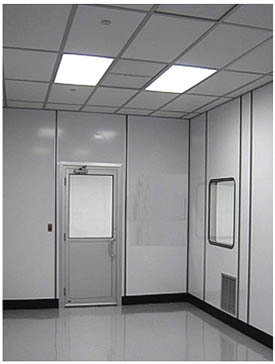
Micro and Nano structure Fabrication Facility
To fabricate a functional micro or nano scale electronic device, stepper or mask-aligner is required to expose a photoresist coated silicon wafer with photomask or reticle containing the micro or nano structure. The stepper is a device which passes light through the photomask or reticle, forming an image of the reticle pattern.Cleanroom environment is used in manufacturing functional electronics device. The state of art SUSS MJB4 contact aligner capable to print 0.5 mm has been installed for research in micro and nano fabrication. This stepper is also attachment of Nano Imprint Lithography for nano size feature fabrication. This contact aligner has 5 exposure modes; Soft Contact, Hard Contact, Vacuum Contact, Soft Vacuum Contact and Gap Exposure.
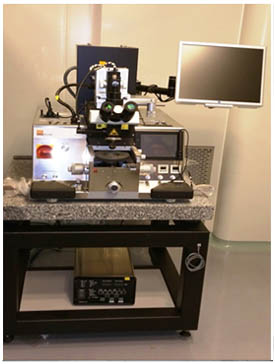
Suss MJB4 Stepper with NIL attachment installed in clean room
Facilities Created with FIST Support
Scanning Electron Microscope for Analytical Research
A state of art EVO18 Scanning Electron Microscope (SEM) of Carl Ziess Company has been commissioned in the department from FIST grant. EVO18 SEM is dual filament (W and LaB6) and EVO 18 SEM is also equipped with Energy and Wavelength Dispersive Spectroscopy (EDS & WDS) analysis tool.. EVO 18 provides excellent quality imaging results from an analytical microscope with the capability to handle all material types. For improved performance, particularly at probe currents associated with X-ray analysis, LaB6 high brightness source is useful. EVO 18 provides excellent quality imaging results from an analytical microscope with the capability to handle all material types. EVO 18 offers Energy and Wavelength Dispersive Spectroscopy (EDS & WDS) ports as standard.
3-Target RF-DC and Magnetron Sputtering System for thin Film Deposition
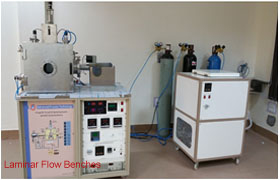
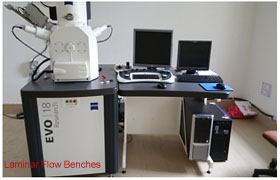
SCANNING ELECTRON MICROSCOPE (SEM ) Model Number: EVO 18 with LaB6 with EDX
Smart Materials and Sensors Laboratory (SMSL)
The Smart Materials and Sensor Laboratory (SMSL) is a unique lab which provides practical knowledge of synthesis and production of nanomaterials for different applications in various fields such as gas sensor, hydrogen storage, energy storage devices, antimicrobial activity and photocatalytic activity, etc.
Research Activities: In SMSL, we are working on the development of nanomaterials for smart gas sensors, renewable energy, food preserve and crop treatment, water purification and remedies of environmental pollution, etc.
Facilities: The major facilities available in the SMSL includes standard equipment, the description about all the instrument available in our laboratory is given below:
| Teflon Linked Hydrothermal Autoclave | ||
| Capacity: Operating Temperature: Heating rate |
50 ml & 100 ml 250 ൦C ≤ 5 ൦C/min |
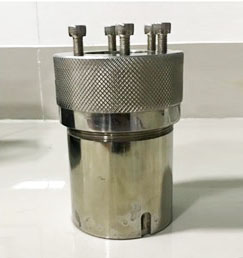 |
| Magnetic Stirrer | ||
| Digital magnetic stirrer with hot plate Maximum speed RPM; Heating capacity (watt) |
1200 300 |
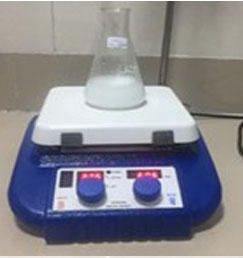 |
| Digital Ultrasonic Cleaner | ||
| Tank volume capacity: Ultrasonic frequency Timer: Temperature range: |
3 liter 40 kHz 5-60 min Ambient -80 ൦C |
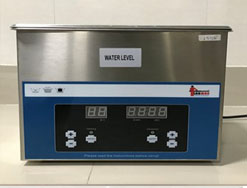 |
| Hot Air Oven | ||
| Temperature range Temperature controller: |
5 ൦C -250 ൦C PID controller |
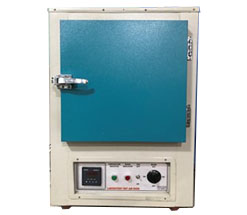 |
| Electronic Balance | ||
| Size of weighting Pan: Readability: Capacity Working condition: Temprature: Humidity: |
90mm 0.1mg 110g 0 ൦C to 50 ൦C 50% to 85% |
 |
| Digital pH meter | ||
pH: |
0 -14 pH 0 -1999 mV 0.01 pH; 1mV 10 ൦C -50 ൦C LED display 230V±10% AC, 50 Hz |
 |
| Vacuum tube furnace | ||
| Tube furnace chamber with quartz tube and couplers Temprature: Power: Temprature Acuuracy: Vacuum: Atmosphere: |
Ambient -1100 ൦C 4KW ±1 ൦C 10-3 Torr Ar and N2, etc. |
 |
Job/ Placement
Job Opportunities
The students from this department have joined premier institutions such as BARC, TIFR, IITs, CAT, IUAC, SSPL, DRDO and ONGC.
Many students have joined Ph.D. programme in the universities abroad.
A number of our students joined Central/State Universities as a faculty member.
More than 70 students have cleared NET/GATE examination till date.
A large number of our students have been selected by UP State Higher Education Service Commission for Lectureship in colleges of UP and Uttrakhand.
Second class Masters degree in the Physics with 55% marks.The eligibility conditions regarding Bachelor’s degree and Intermediate examinations are same as for admission to M.Sc. programme. Intake
- 20 for M.Sc. programme
- 10 for M.Phil programme Courses along with Syllabus
Attached Job Opportunities and Placement The students from this department have joined premier institutions such as BARC, TIFR , IITs, CAT, IUAC, SSPL, DRDO and ONGC .
Many students have joined Ph.D. programme in the universities abroad.
A number of our students joined Central/State Universities as a faculty member.
More than 70 students have cleared NET/GATE examination till date.
A large number of our students have been selected by UP State Higher Education Service Commission for Lectureship in colleges of UP and Uttrakhand.
Gallery
Research & Publication
This page is being uploaded....
Achievements
This page is being uploaded....
Learning Resources
- 1. AIP Publishing
- 2. APS Journals
- 3. IOP Journals
- 4. JSTOR Home
- 5. Physics eBooks
- 6. Springer Nature
VIRTUAL LABORATORIES
LINKs OF VIRTUAL LABORATORIES FOR PHYSICS EXPERIMENTS 1. To perform Mechanics, Thermodynamics, Optics, Electricity and Magnetism, Basic Electric Circuits, Modern Physics related experiments
https://vlab.amrita.edu/?sub=1
2. To perform general physics experiments
https://bop-iitk.vlabs.ac.in/basics-of-physics/
3. To perform digital electronics based experiments
https://de-iitr.vlabs.ac.in/
4. To perform basic electronics based experiments
http://4.http//vlabs.iitkgp.ernet.in/be/#

No. of Seats

